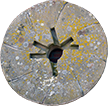
A sea otter and pup. The sea otter is an example of what biologists call a keystone species — a species that has an effect on its environment that is outsized relative to its biomass. The sea otter's environment is dominated by kelp forests, the "trees" of which anchor themselves to the sea bottom with structures call holdfasts. Unlike the roots of land trees, which are complex nutrient-gathering networks, holdfasts provide little more than the anchoring function. Unfortunately for the kelp, sea urchins love to eat kelp roots — the holdfasts. When they do, the kelp plant floats away and dies. Sea otters, which prey on sea urchins, protect the kelp, and thus the entire ecosystem.
Influencers can serve similar functions in groups and organizations. They might be unimportant in almost every respect, but given authority, they can begin exercising influence, in the right ways and at the right times. In that way, they can enable the entire organization to make changes that affect everyone, including the influencers. Photo courtesy U.S. National Parks Service.
Much has been written about Power, Authority, and Influence, and a lot of it has landed on the Web. Google reports 976 million hits. Impressive, but to keep things in perspective, how to find a woman get 4.19 billion hits, and how to find a man gets 8.1 billion. Evidently, we care about Power, Authority, and Influence, but not as much as some other things.
I haven't looked at all 976 million pages yet, but I'm a little troubled by what I've found so far. Given our interest, one might expect that we'd have a clearer understanding of Power, Authority, and Influence, and their interrelationship, than we do.
True, what I found is a good beginning, but it's only a beginning. It ignores an important reality of human systems: human systems are systems. Any definitions of Power, Authority, and Influence in human systems must take into account the web of interrelationships of the human members of that system. Our understanding of Power, Authority, and Influence must encompass the idea that everyone affects everyone.
Let's look at these three concepts one by one. For each one, I'll give the conventional definition — the one I found over and over again in my unscientific survey — and then take a look at a systems view of the same concept.
- Influence
- Conventionally, to influence people is to change the opinions or behavior of others.
- From a systems Any definitions of Power, Authority,
and Influence in human systems
must take into account the web
of interrelationships of the human
members of that systemview, influencers do not change opinions or behavior. Influencers provide a nudge, a catalyst, or a force that people use to change themselves. When influencers engage in this way with the influenced, they are in turn influenced themselves. - Power
- Conventionally, Power is the ability of an influencer — a person or group or institution — to change people, by some means or other.
- To believe that influencers do the changing is to ascribe more power to them than they actually have. Influencers say or do, but the people they influence are the ones who actually do the changing. Two powers are needed: the power to influence and the power to change. The power that actually matters is thus an attribute of the system, rather than an attribute of influencers.
- Authority
- Conventionally, Authority is legitimate Power — some say "legitimized" Power.
- Authority need not be "legitimate." Rather, authority is something conferred, voluntarily or under duress, on an influencer or would-be influencer by the person or people the influencer wants to influence. Because it's conferred on the influencer by the influenced, both parties are involved. Authority, too, is an attribute of the system.
When we assess the effectiveness of attempts to influence, the legitimacy of authority matters less than the precise kind of authority that the influenced have conferred on the influencer. A catalog of the kinds of authority will be our topic in two weeks. ![]() Next issue in this series
Next issue in this series ![]() Top
Top ![]() Next Issue
Next Issue
Are your projects always (or almost always) late and over budget? Are your project teams plagued by turnover, burnout, and high defect rates? Turn your culture around. Read 52 Tips for Leaders of Project-Oriented Organizations, filled with tips and techniques for organizational leaders. Order Now!
Your comments are welcome
Would you like to see your comments posted here? rbrenaXXxGCwVgbgLZDuRner@ChacDjdMAATPdDNJnrSwoCanyon.comSend me your comments by email, or by Web form.About Point Lookout
 Thank you for reading this article. I hope you enjoyed it and
found it useful, and that you'll consider recommending it to a friend.
Thank you for reading this article. I hope you enjoyed it and
found it useful, and that you'll consider recommending it to a friend.
This article in its entirety was written by a human being. No machine intelligence was involved in any way.
Point Lookout is a free weekly email newsletter. Browse the archive of past issues. Subscribe for free.
Support Point Lookout by joining the Friends of Point Lookout, as an individual or as an organization.
Do you face a complex interpersonal situation? Send it in, anonymously if you like, and I'll give you my two cents.
Related articles
More articles on Organizational Change:
 Don't Rebuild the Chrysler Building
Don't Rebuild the Chrysler Building- When we undertake change, we're usually surprised at the effort and cost required. Much of this effort
and cost is necessary because of the nature of the processes we're changing. What can we do differently
to make change easier in the future?
 Change How You Change
Change How You Change- In the past two years, your life has probably changed. Do you commute over the same route you did two
years ago? Same transportation? Same job? Same company? Same industry? Change is all around, and you're
probably pretty skilled at it. You can become even more skilled if you change how you change.
 The Ties that Bind
The Ties that Bind- Changing anything in an organization reveals how it's connected to its people, to its processes, to
its facilities, and to the overall context. Usually, these connections reach out much further into the
organization than we imagine.
 How to Find Lessons to Learn
How to Find Lessons to Learn- When we conduct Lessons Learned sessions, how can we ensure that we find all the important lessons to
be learned? Here's one method.
 Storming: Obstacle or Pathway?
Storming: Obstacle or Pathway?- The Storming stage of Tuckman's model of small group development is widely misunderstood. Fighting the
storms, denying they exist, or bypassing them doesn't work. Letting them blow themselves out in a somewhat-controlled
manner is the path to Norming and Performing.
See also Organizational Change for more related articles.
Forthcoming issues of Point Lookout
 Coming October 1: On the Risks of Obscuring Ignorance
Coming October 1: On the Risks of Obscuring Ignorance- A common dilemma in knowledge-based organizations: ask for an explanation, or "fake it" until you can somehow figure it out. The choice between admitting your own ignorance or obscuring it can be a difficult one. It has consequences for both the choice-maker and the organization. Available here and by RSS on October 1.
 And on October 8: Responding to Workplace Bullying
And on October 8: Responding to Workplace Bullying- Effective responses to bullying sometimes include "pushback tactics" that can deter perpetrators from further bullying. Because perpetrators use some of these same tactics, some people have difficulty employing them. But the need is real. Pushing back works. Available here and by RSS on October 8.
Coaching services
I offer email and telephone coaching at both corporate and individual rates. Contact Rick for details at rbrenaXXxGCwVgbgLZDuRner@ChacDjdMAATPdDNJnrSwoCanyon.com or (650) 787-6475, or toll-free in the continental US at (866) 378-5470.
Get the ebook!
Past issues of Point Lookout are available in six ebooks:
- Get 2001-2 in Geese Don't Land on Twigs (PDF, )
- Get 2003-4 in Why Dogs Wag (PDF, )
- Get 2005-6 in Loopy Things We Do (PDF, )
- Get 2007-8 in Things We Believe That Maybe Aren't So True (PDF, )
- Get 2009-10 in The Questions Not Asked (PDF, )
- Get all of the first twelve years (2001-2012) in The Collected Issues of Point Lookout (PDF, )
Are you a writer, editor or publisher on deadline? Are you looking for an article that will get people talking and get compliments flying your way? You can have 500-1000 words in your inbox in one hour. License any article from this Web site. More info
Follow Rick
Recommend this issue to a friend
Send an email message to a friend
rbrenaXXxGCwVgbgLZDuRner@ChacDjdMAATPdDNJnrSwoCanyon.comSend a message to Rick
![]() A Tip A Day feed
A Tip A Day feed
![]() Point Lookout weekly feed
Point Lookout weekly feed
 My blog, Technical Debt for Policymakers, offers
resources, insights, and conversations of interest to policymakers who are concerned with managing
technical debt within their organizations. Get the millstone of technical debt off the neck of your
organization!
My blog, Technical Debt for Policymakers, offers
resources, insights, and conversations of interest to policymakers who are concerned with managing
technical debt within their organizations. Get the millstone of technical debt off the neck of your
organization!